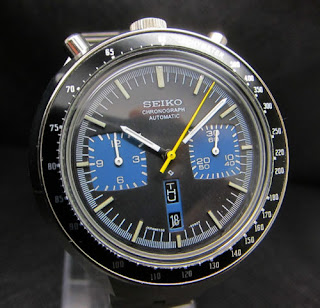Today's watch is the super-cool, super '70s Seiko "Chronograph Automatic, " or "Seiko Bullhead Chronograph" as it's come to be called by collectors. So named because the pusher buttons are at the top of the case (rather than the side) and are reminiscent of a bull's horns, with the crown between the two pushers completing the look of a bull's head.
I've also heard it called the "UFO" due to its flying saucer appearance.
Seiko made this chronograph model from about 1974 to 1979.
Here are the details on this particular specimen: All stainless steel "hidden lug" case with screw back. Case 46mm high by 43.5 mm wide, not including crown, 46mm high, and 15mm thick. The head alone on this watch weighs 3.3 ounces. Few dings on the case, nothing serious. Bezel insert is in excellent condition. Excellent condition original dial, brown with gold colored registers. Excellent original crown and original pusher buttons. Crystal is a replacement, a correct beveled edge glass crystal.
Movement: 21 jewel Caliber 6138 movement winds and sets perfectly, keeps time to within 2 min/day. All chrono functions operate perfectly ... start, stop, and reset. Chrono zeroes up perfectly. Not known when last serviced. Day and date are both quick adjustable by pulling out crown to first "click" and turning clockwise to adjust date, and counter-clockwise to adjust day.
Brand new aftermarket "fishbone" bracelet with signed Seiko deployment clasp. The case serial number of 658296 dates this specimen to May 1976.
The Seiko "Chronograph Automatic" really shook up the market in its day because this 12 hour model sold for quite a bit less money than 12-hour chronographs from such companies as Heuer or Breitling. First models of the Seiko sold for around $145, while a Heuer Autavia retailed for around $230 with a steel bracelet. Seiko's chronograph sold quite well in the states because Seiko had already established a solid reputation. The idea of no running seconds already had a precedent with the Caliber 11/12, made by Dubois Depraz with financial and technical assistance from Heuer, Hamilton/Buren, and Bretling. All of these companies had an interest in this chronograph movement and would eventually come out with chronographs containing the Caliber 11 and its improved version, the Caliber 12.
The Seiko 6138 was quite a mechanical marvel in its time, and I believe matched the technical excellence of not only only the Caliber 11/12, but also the Zenith Caliber 3019, used in its El Primero automatic chronograph. Granted, Seiko had five years to study those movements and learn from them, but take into consideration that Seiko made the movement entirely in house, including escapement and hairspring. The movement is amazingly durable. Even the most cosmetically beat up specimens frequently have working movements!
Today, the Seiko Bullhead is popular among collectors, partially because they provide the biggest bang for the buck for a 12-hour chronograph. But they are going up in price. A few years ago, you could buy them all day long at $250 and under, many complete with the watch's signature "fishbone" bracelet. Now, it's not unusual to find them starting at $350 to $450, and if you find one with an ORIGINAL fishbone bracelet (not aftermarket) you can add another $100 to that price.
Because it sits so high on the wrist, the watch tended to get banged around quite a bit, both on the sides and on the surface of the bezel insert on which is printed all the tachymeter numbers for calculating speed of a moving object. This specimen has a few dings on the case, but the bezel insert is in surprising good shape.
Two color combinations of this model were offered. This one is the brown dial with gold colored registers; the other is a black/blue combination. I'm not aware of one color combo being more desirable than the other.
The crown on this watch can actually be used as a secondary means to wind the movement. Most Seiko automatic utilize the crown only to set the time and calendar functions as needed. They rely solely on the rotation of the rotor to wind the mainspring.
This is one watch that definitely requires a bracelet. A leather band on this watch looks ridiculous in my opinion. The best option for a bracelet is of course the original "fishbone" bracelet that it came with. The bracelet has earned the name among collectors because the thin inner links of the bracelet look like the bones of a fish once it has been filleted. The problem is, original bracelets are nearly impossible to find because they tended to take quite a beating by their original owners. Enter the Chinese, with their amazing ability to duplicate nearly anything, especially once it's learned there is a demand for it! There are a number of sellers on eBay offering aftermarket "fishbone" bracelets, specifically for the Seiko Bullhead that are near-perfect replicas of the originals, right down to the perfect fit between the end pieces and the watch's lugs. The bracelets sell for between $35 and $50. They are generous in size (I'm certain they will fit up to an 8-inch wrist) and, honestly, I have no problem attaching one of these to a Bullhead (as I have with this one) as long as one is honest about disclosing the fact.
I should add that complete Chinese-made fakes of the Seiko Bullhead have appeared on the market. They are fairly obvious to spot. Apart from the fact that most are shipped from China (which should raise a red flag immediately) the aftermarket dials and hands are fairly easy to spot. But just be aware. Here is one such example:
Here are some additional photos of this REAL ONE I have:
The watvh is for sale, and if you'd like to make an offer on it, please contact me by clicking here.
You can see my complete listing of watches for sale here.
Sincerely,
Bruce








No comments:
Post a Comment